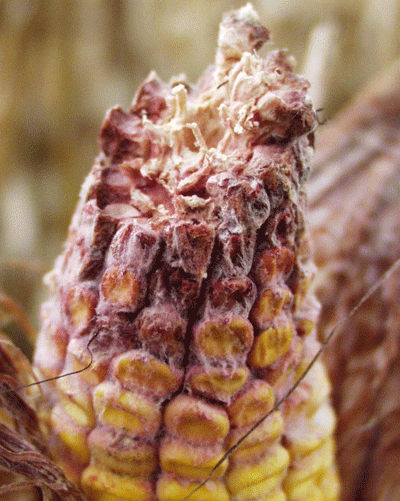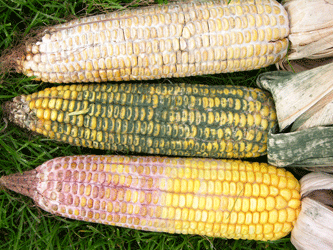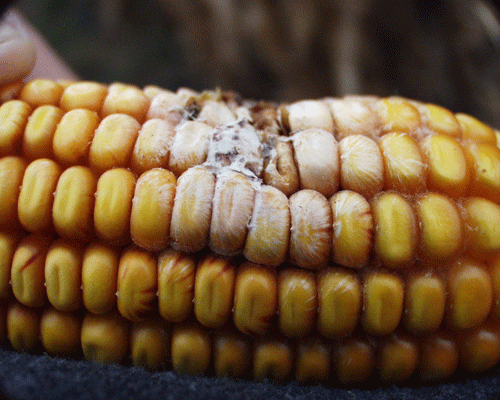Ear Moulds and Implications
by ONTARIO'S CROP SPECIALISTS
Gibberella ear rot
- The most common and important ear mould in Ontario is Gibberella zeae which is the sexual reproductive stage of Fusarium graminearium
- Infection often begins at the ear tip and moves down towards the ear base.
- Although the fungus can produce a white-coloured mould which makes it difficult to tell apart from Fusarium Kernel Rot, the two can be distinguished easily when Gibberella produced its characteristic red or pink colour mould.
- Toxins produced by Gibberella include Deoxynivalenol (vomitoxin or DON), Zearalenone (ZEN) and T-2 toxin. If grain is to be used for feed, a myctoxin test is recommended.
- Reducing toxin levels by combine adjustment and grain cleaning is difficult.
 Diplodia ear rot
Diplodia ear rot
- The characteristic ear symptom of Diplodia maydis infection is a white mould that begins at the base of the ear and can eventually cover and rot the entire ear.
- Mould growth can also occur on the outer husk which has small black bumps (pycnidia) embedded in the mould.
- No known mycotoxins produced.
 Penicillium ear rot
Penicillium ear rot
- Penicillium oxalicum produces a light blue-green powdery mould which grows between the kernels and cob/husk surface.
- Can be a serious problem if corn is stored at high moisture levels (greater than 18 percent).
- Ochratoxins are produced by other Penicillium species (P. oxalicum does not produce ochratoxin; rarley detected in Ontario). •
Cladosporium ear rot
- Cladosporium was particularly prominent in 2009.
- Delayed maturity, frost events and wet conditions contributed to the Cladosporium development
- Cladosporium produces a black mould on the ear and kernel surface.
- Cladosporium grows mainly on the kernel surface or between kernels and are not great colonizers. They are often referred to as “surface contaminants” and therefore the mould (mycelium) they produce rubs of easily. Basically as the corn dries often the Cladosporium mould dries as well and friction such as combining will remove it to some degree.
- Cladopsorium does not produce any known toxins and if properly stored or ensiled mould growth should stop under anaerobic (oxygen-free) conditions.
 Fusarium ear rot
Fusarium ear rot
- Unlike Gibberella, Fusarium infected kernels are often scattered around the cob amongst healthy looking kernels.
- In most cases it does not fuse the husk to the ear like Gibberella.
- A ‘white streaking’ or ‘star-bursting’ can be seen on the infected kernel surface.
- Although many Fusarium species may be responsible for these symptoms, the primary species we are concerned about in Ontario is Fusarium verticillioides which produces the toxin Fumonisin.

Back
to Top




